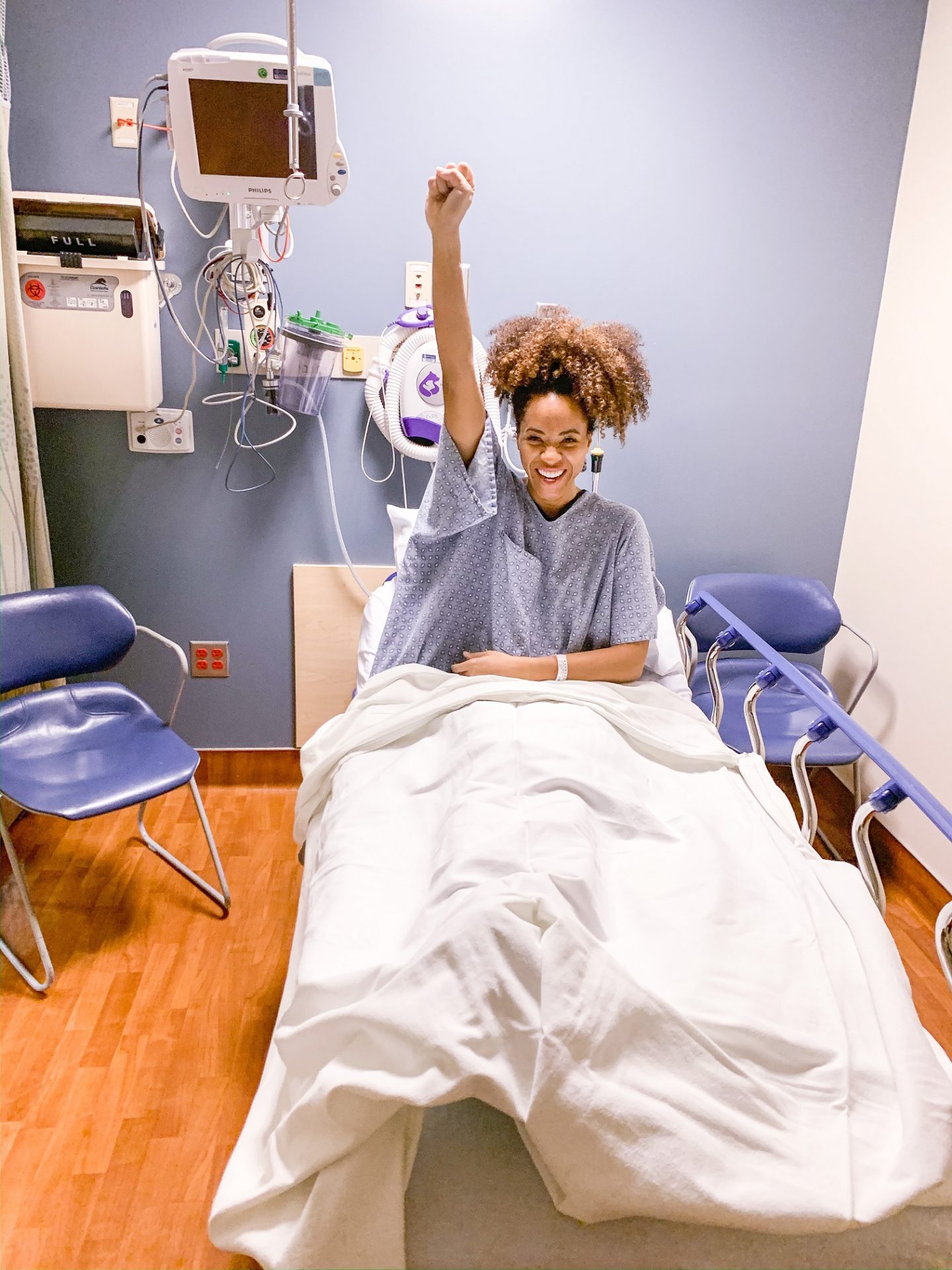
What is an endometrial ablation
An Endometrial ablation is a medical procedure which removes the entire uterine lining from the inside of your uterus. Many women choose to have an ablation for endometriosis or other abnormal uterine issues. I also have learned through research that ablation of the endometrium may help women who have heavy or prolonged periods. And it may also help women who bleed in between periods.
Why did I choose to get an endometrial ablation
I chose to have an ablation of the endometrium because my periods were so heavy as a side effect of my endometriosis. For most of my life I could deal with the heaviness, but after giving birth to my fourth child my cramping was literally unbearable. To put this in perspective, I on purpose gave birth to my last child without any medications and chose to practice hypno birthing to “gently” guide her out of my body. (I can share more about that on another post!) My point is, I can deal with pain. But every month after giving birth to her, my cramps got worse and worse. Then for three months in a row, I begin to throw up violently on the first day of my period, and that is when I said enough is enough.
Other Options
When I went to the doctor he presented me with several options.
1. Begin taking a form of birth control to even out my hormones.
2. Get a hysterectomy
3. Get an ablation of endometrium
Cleary I chose to get the ablation, but let’s quickly talk about why I didn’t choose the other two options.
For me birth control was a quick “no” because I hated the way it made me feel. And the idea of taking a pill or going to see a doctor every few months to get something inserted or shot into me for the rest of my forever, was also not my idea of “living my best life”
I opted away from the hysterectomy because the surgery is pretty invasive. The incision is a straight line right on top of where your bikini might hit, and is very similar to a c-section scar. Also the recovery length is very similar to… you guessed it a C-section. The pros of a hysterectomy are that you have no more uterus so you will have no more bleeding, and no more periods, but I was really hoping for a happy medium between the birth control and ripping my uterus out my body.
Ablation of endometrium procedure
The major differences between a hysterectomy and an ablation of endometrium is that in an ablation, your uterus is still in your body. The procedure works to damage the lining of your uterus in a way that will prevent it from regenerating every month, thus preventing it from sloughing away every month.
The cons and risks of endometrial ablation risks
Bleeding & Infection
One of the major cons of ablations, as compared to a hysterectomy, is that there is a chance that you may still have slight bleeding during your regular monthly menstrual cycle. The bleeding isn’t heavy but for some people is still a regular part of their lives.
And because this is a medical procedure there is a risk of infection after the surgery, that every good medical professional will communicate to you. The risk is low, but it’s fair to mention that infection is a risk.
Loss of fertility
For me, we were done having kids so the risk of a loss of fertility was a big deal. But if you are still considering adding to your family an ablation of endometrium is probably not your best option. This procedure would damage the very lining that would nurture a baby to life, and when it is damaged it is irreversible. Before make the choice to have an ablation you will really want to decide if your family is complete prior to getting an ablation of endometrium
For me the choice was easy to have an ablation for my endometriosis. I would happily take the risk of occasionally spotting for the reward of being able to live a normal life during what would have been my menstrual cycle.
Types of endometrial ablations
There are several types of ablation of endometrium. Like a ton!! So I am going to share the three that my doctor shared with me. Essentially all types of ablations apply either extreme heat or extreme cold in order to destroy the lining of your uterus.
Laser
In this option the doctor will insert a laser into your uterus to burn the uterus. My understanding is that this option is effective but time consuming and it is easy to miss a spot of the lining and can lead to spotting after the procedure.
Hot water
This option is great for getting every nook and cranny of the uterine lining but can sometimes burn parts outside of the uterus as doctors must demonstrate incredible precision to insert and drain the water in and out of the uterus.
Balloon
This is the option I had done. The doctor inserts a balloon that is heated up to extreme temperatures then once cooled removed without causing accidental burning. The downside is that it is not as effective at getting into every tiny crevice as the hot water alone. The balloon procedure is the goldilocks procedure in the world of options for the ablation of endometrium. For me it was the best choice, talk to your doctor about your priorities and desired outcomes as you decide which option is best for you.

Endometrial ablation process:
If you are a details person like me, you will appreciate this step by step break down of what happens during an ablation of endometrium. (If you are not, feel free to scroll down past this part by clicking here.)
Most likely you may have an endometrial ablation at a hospital, but depending on your doctor’s facility it may be in their office. This is an outpatient procedure and took just over 4 hours.
Pre surgery
You will be asked to fast before your surgery. My doctor asked for a 12 hour fast and lucky for me my surgery was in the morning. I also was instructed to shower several times with an antibacterial soap several times to reduce the risk of infection.
- Fast (ask your doctor for your specific length)
- Shower several times with antibacterial soap
- Do not put on any lotions, deodorants or perfumes
Surgery
I was under general anesthesia during my procedure and for me that is the worst part. I get so nervous about all the what ifs when I know I will be unconscious. Before we start, I even go as far as to tell the doctor “I completely realize, I am your 11am appointment today, and this is very routine for you, but please remember that I am a real-life person, and I am depending on your expertise to keep me safe.” I know that is a little morbid, but I don’t want my doctor to be in a rush to go golfing after, and I giving my doctor a kind reality check-in makes me more confident that they might here my tiny voice as they think about the next thing on their to-do list.
- You will be asked to remove clothing and be given a gown to wear. It’s a great idea to leave valuables like your wedding ring, jewelry and watches at home.
- Be prepared to wait for a while while sitting in your robe as you wait for your procedure to begin. If you tend to be a person who gets cold easily tell your nurse. The nurses are so incredible about making you comfortable before and after.
- Before you are put under, you will likely sign a few papers that authorize the procedure and that you are aware of all risks like infertility for example
- After you are under anesthetics your doctor will drain your bladder, open your cervix and insert your ablation tool of choice.
- Your cervix lining will be evaluated to ensure optimal results
- Lastly, you will be brought to a room to recover while the anesthetics exit your system.

What happens after an endometrial ablation?
The immediate recovery process will vary, depending on what type of ablation you had and the type of anesthesia used. I had general anesthesia. The first faces that I saw were the nurses, and my husband was called when I woke up from the procedure and deemed ready to be discharged. Before I was discharged the doctor came in and gave me my final discharge notes. Plan for this part of the process to take an additional two hours.
Discharge notes
- You may also have a watery-bloody discharge for several weeks
- Discharge is normal as long as it doesn’t smell weird
- Strong cramping is normal for the first few days as is vomiting
- Take the prescribed medicines for pain as needed
- Do not:
- wear a tampon for at least 3 weeks
- douche for at least 3 weeks
- have sex for at least 3 days
- think you are superwoman and think you can resume normal activities the next day even if you feel great
I left the hospital virtually pain free and slept the entire day on the couch completely unbothered! Isn’t it a shame that we have to have surgery to experience that miracle! hehe
The day after my endometrial ablation
After having birthed 3 babies, I thought I would feel like I had been hit by a train after my ablation. I took my pain meds the moment my eyes opened because I didn’t want to chance even a touch of pain. But I am happy to report, that I almost forgot to take them for the rest of the day.
Normally after a major procedure your body begins to ache to remind you that it’s time to reload on your pain pills, and my body gave me no such urge. But yes… I took them anyway because the doctor told me not to be superwoman and I am a good listener.
By day 3 I was completely off meds and pretty much back to my normal routine. I even went to hot yoga, which was not very smart, but I felt great.
My first period after my endometrial ablation
For me this was the real test, was it all worth it… Would my pain go away.. Would I be period free???? The verdict YESSS I was pain free. I was hesitant to go dancing around and proclaiming the good news of my ablation for endometrium but I sure wanted to 30 days out.
Period Pain before my ablation – 10
Period Pain after ablation – 0
The only bummer was that I did still have watery spotting pretty much the entire month. The doctor wasn’t confident it would go away as someone did experience light spotting/bleeding. I was a little sad that I might be part of the small percent but so relieved that the procedure whipped out my pain that really a little panty liner wasn’t going to take away my shine!
6 months after my endometrial ablation
I am happy to report, I am still pain free! I do spot for about a day, on my first day of my “cycle” but literally I can wear the same tiny panty liner the entire day and it does the trick. Which is night and day from the boxes of tampons I use to go through a week before my ablation.
Clearly I would recommend this procedure to anyone suffering from severe menstrual pain. Especially if you are in a place where child bearing is not an importance factor for you. Not only can I wear white pants with confidence, but I don’t’ experience the monthly bloating and pain of my menstrual cycle. I am hopeful that as time continues that light spotting I experience on day 1 will also go away.
Thanks for reading my blog! Please let me know in the comments if you have any questions. You can also DM me on Instagram.
xo- Chantea

Want to read more?
How we beat Infertility ; Our Adoption Story; The marriage 30 day sex challenge